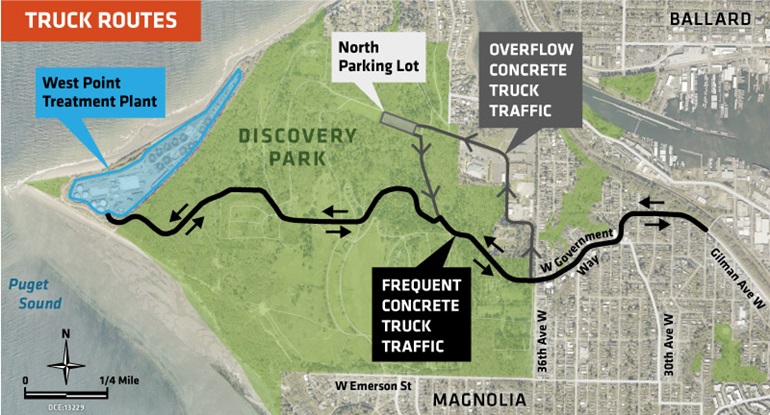Hundreds of trucks deliver 1,600 tons of concrete, laying the foundation for better power quality at West Point Treatment Plant
Summary
In the latest in a series of improvements at West Point Treatment Plant, trucks are delivering more than 1,600 tons of concrete needed to house new onsite batteries that will provide operators with a better-quality power supply.
News
A steady stream of trucks – about 80 trips per day over three days – is delivering more than 1,600 tons of concrete needed for the foundation of a new building that will house onsite batteries, providing West Point Treatment Plant operators with a high-quality power supply. It’s the first project of its kind in a major metropolitan region.
A momentary power disruption - even one that lasts less than a second - can bring vital equipment to a halt at the region's largest treatment facility. The onsite battery system will prevent potential voltage sags from the Seattle City Light transmission line from impacting the plant's critical operating pumps.
It is the latest in a series of improvements since King County Executive Dow Constantine signed an emergency declaration in February 2021, making it possible for the Wastewater Treatment Division to expediate capital projects at the Puget Sound region's largest treatment plant.
“We’re creating the foundation — in this case literally — for more resilient, more reliable wastewater treatment, to better protect our region’s water quality for generations to come,” said Executive Constantine. “The massive new onsite batteries we’re installing at West Point will provide operators with the uninterruptable power supply needed to protect Puget Sound around the clock as we experience more frequent, severe rainstorms due to climate change.”

The Wastewater Treatment Division last year demolished a building that once stored chlorine to make room for the onsite batteries. The new building will house the batteries as well as support features, including fire suppression, maintenance access, heating, ventilation, and air conditioning.
Trucks will deliver enough concrete to build a 4-foot-thick foundation for the new 24,000-square-foot building. The first delivery occurred before sunrise Saturday. There will be two more deliveries, on Thursday and April 6, starting at 3 a.m. Local streets and Discovery Park will remain open during the project.
While the plant's location along Puget Sound is ideal for discharging cleaned wastewater, being at the end of Seattle City Light's power lines makes the plant especially vulnerable to voltage sags. The Wastewater Treatment Division is working closely with Seattle City Light to improve the power feed while simultaneously installing the new power quality improvement system.
Similar to when a circuit breaker trips in a home, voltage fluctuations can cause the pumps at the 1.45 million-square-foot treatment plant to protectively shut down. That can cause wastewater flowing into the plant to be re-directed through an emergency bypass and discharge directly into Puget Sound. It prevents damage to the massive pump system and other plant equipment but impacts water quality in Puget Sound.
Once the capital project is complete, the onsite batteries will stabilize the power supply so treatment operations can continue without interruption.
"West Point Treatment Plant is a core part of our wastewater infrastructure in the Puget Sound region, and we need it to function at its very best if we are to have the exceptional water quality that the people of King County value and deserve," said Kamuron Gurol, Director of the Wastewater Treatment Division. "This first-of-its-kind project requires ingenuity and resourcefulness - we're fortunate to have a talented workforce that has both."
The latest in a series of improvements at West Point
It is one of several projects that will make the treatment plant safer, more reliable, and more resilient as the region experiences more frequent, severe rainstorms due to climate change. The Wastewater Treatment Division in 2022 completed seismic upgrades and will replace raw sewage pumps, some of which have been operating nearly nonstop since the plant opened in the 1960s.
West Point treats wastewater from homes and businesses in Seattle, Shoreline, north Lake Washington, north King County, and parts of south Snohomish County. It can treat up to 440 million gallons per day during heavy rainfall. It requires about 10 megawatts of electricity to operate each day, which is about the same amount needed to power 11,000 single-family homes.
The treatment plant is expected to operate at maximum capacity more often as the result of climate change. More frequent, severe storms also increase the likelihood that voltage sags will occur.
Multimedia
- PHOTO: Laying foundation for better power quality at West Point
- VIDEO: B-roll: First concrete pour for West Point power improvement
- VIDEO: B-roll of West Point Treatment Plant
- VIDEO: Major improvements at West Point Treatment Plant
- VIDEO: Seismic upgrades at West Point Treatment Plant
Related
- Overview of West Point power quality improvement project
- TRACKS: An interactive map of environmental stewardship
Quotes
We’re creating the foundation — in this case literally — for more resilient, more reliable wastewater treatment, to better protect our region’s water quality for generations to come. The massive new onsite batteries we’re installing at West Point will provide operators with the uninterruptable power supply needed to protect Puget Sound around the clock as we experience more frequent, severe rainstorms due to climate change.
- Dow Constantine, King County Executive
West Point Treatment Plant is a core part of our wastewater infrastructure in the Puget Sound region, and we need it to function at its very best if we are to have the exceptional water quality that the people of King County value and deserve. This first-of-its-kind project requires ingenuity and resourcefulness - we're fortunate to have a talented workforce that has both.
- Kamuron Gurol, Director of the Wastewater Treatment Division
Contact
Marie Fiore, Wastewater Treatment Division, 206-263-0824

 Translate
Translate